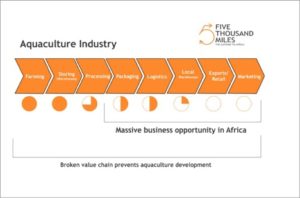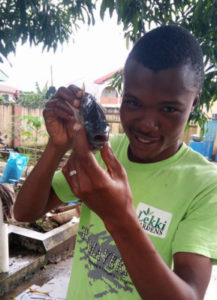Young Fish Farmer in Africa Talks Sustainable Aquaculture
Editor’s note: The following is a guest blog post by one of GAA’s 30 Under 30 members, Efejuku Iceboss Precious. Efejuku is the CEO of Tajin Farms, a Nigerian catfish processing operation and fingerling supplier that takes a sustainable approach to their business practices. This is the third post in a five-part series by members of the 30 Under 30, in which Efejuku explores the sustainability of aquaculture, specifically in Nigeria, Uganda and Kenya.

Sustainability focuses on meeting the needs of the present without compromising the ability of future generations to meet their needs. It is structured on three pillars: profits, planet, and people. In other words, to attain sustainability, fish farming has to be profitable, environmentally friendly and widely accepted by the people. In this context, the health of the fish has to be highly considered, too.
Some people want to farm for profit, neglect the health condition of the fish and also damage the environment while doing so. This is not a sustainable method. There has to be harmony with making sure that there is a balance.
Case Study: Nigeria
Nigeria, an African country on the Gulf of Guinea, has a population of more than 168 million people. The total fish demand is estimated to be around 4 million metric tons. About 2 million metric tons of fish is imported yearly to meet the demand of the growing population. The most common fish species that farmers grow for commercial purpose are carp, tilapia and catfish. Catfish is highly acceptable and commercially produced in large quantities. There are several fish farming clusters in Nigeria — this can be the key to achieve sustainability and food security. However, these farmers do not understand the meaning of the term sustainability as they default in one or two of the key pillars of sustainability. They lack the adequate information and proper training on best aquaculture practices. Most times the environment is affected by activities of the farmers, leading to environmental pollution. Most of the feeds used by these farmers are very expensive and sometimes not affordable because they are imported. The profit made by these farmers after every harvest is very small, and most farmers run at loss. This discourages them from going into fish farming as a business. However, catfish is widely accepted by the people.
The keys to sustainable fish farming start from the bedrock as fish farming should be introduced into the curriculum from primary education. More institutions and research centers should be set up to encourage and train farmers in the rural areas. Nigeria is blessed with all the natural resources required to formulate a very standard fish feed which can be produced locally and sold cheaper to ensure farmers are profitable. More investors should look into setting up commercial fish feed companies as the very few dominate and monopolize the system.

Case Study: Uganda
Uganda is a land-locked country in East Africa and has a population of about 44 million people. There is an impressive array of fish species from the wild in rivers, lakes and various water bodies. The aquaculture industry is growing primarily because of huge demand for seafood and wild fish populations being depleted. Uganda produces up to 150,000 metric tons of fish from aquaculture, which includes production from small-scale fish farmers, emerging commercial fish farmers, stocked community water reservoirs and minor lakes. There are an estimated 50,000 ponds throughout the country with an average surface area of 500 square meters per pond. The catfish and the Nile tilapia are the lead farmed fish. There are a few challenges to attaining sustainable farming in Uganda, which includes getting access to quality fish seeds, access to quality, low-priced fish feed and adequate knowledge of aquaculture. There are few research and training centers for aquaculture.
Fish farming will only be sustainable in Uganda when the farmers have adequate knowledge and proper information, by setting up centers for research and development where best aquaculture practices are taught. The farmers should have access to quality seeds that are fast growing and viable. Investors should look into setting up commercial feed manufacturing companies, commercial hatcheries and large processing factories to meet the growing demand for fish. The feeds and seeds should be affordable and accessible.
Case Study: Kenya
Kenya is a country in East Africa with coastline on the Indian Ocean with a population of more than 50 million people. The growing population has led to a decline in fish stocks at Lake Victoria. This has made fish a luxury food, placing this healthy source of protein out of reach of many people. More than 70 percent of the fish and fish products consumed locally have been from wild-caught fisheries, principally from Lake Victoria. However, overfishing, pollution and use of illegal fishing gear has led to an alarming decline in fish populations. This has led to a deficit in supply, hurting the wild-caught industry. The aquaculture industry has so much potential to take this deficit and use it as an advantage: the opportunities within the industry are vast.
 Improving Fish Farming Across the Board
Improving Fish Farming Across the Board
The best approach to ensure sustainable fish farming across board is first to encourage best aquaculture practices by constantly training and retraining farmers, with adequate information and knowledge of fish farming sustainable aquaculture will become a reality. To encourage the setup of training and research centers for aquaculture, investors should look into setting up more fish feed manufacturing companies, fish processing companies and standard hatcheries. Finally, aquaculture should become a part of primary school curriculum. People should be encouraged to farm responsibly and eat more farmed fish and discourage eating endangered species of fish from the wild. As the demand for fish continues to grow alongside African populations, sustainability must remain a top priority and important consideration of future production.



